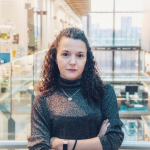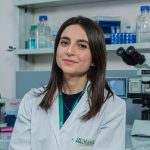My name is Monica Tambalo and I am a postdoctoral researcher in Dr. Simona Lodato’s lab at the IRCCS Humanitas Clinical and Research Center in Milan. My research focuses on understanding the molecular mechanisms of neurogenesis and linking them to neurodevelopmental diseases. In my preLights, I will be mainly talking about cell fate decisions, brain development, and the emerging potential of organoids as human model systems.
I graduated in Molecular Biology from the University of Padua in 2010, after spending one year as an Erasmus student in Paris where I studied at the Master of genetics (Paris Diderot University) and worked in the laboratory of Dr. Jamilé Hazan. I then joined Prof. Andrea Streit lab for my PhD in the Centre of Craniofacial & Regenerative Biology at King’s College London. There my work aimed at deciphering the molecular mechanisms regulating the early cell fate decisions of sensory progenitors, with a focus on how inner ear precursors are established. In 2015, I joined Dr. David Wilkinson’s lab at the Francis Crick Institute where I studied how neurogenesis becomes patterned within the developing zebrafish hindbrain. I am now working in Dr. Simona Lodato’s lab, supported by the Umberto Veronesi Foundation Fellowship. I am currently investigating cell fate decisions in the human cortex and the impact of infantile epilepsy in cortical development.
A choroid plexus apocrine secretion mechanism shapes CSF proteome and embryonic brain development
Monica Tambalo, Vanessa Aragona
Generating human neural diversity with a multiplexed morphogen screen in organoids
Monica Tambalo
Stem cell-derived mouse embryos develop within an extra-embryonic yolk sac to form anterior brain regions and a beating heart
AND
Mouse-embryo model derived exclusively from embryonic stem cells undergo neurulation and heart development
Monica Tambalo et al.
Optogenetic control of apical constriction induces synthetic morphogenesis in mammalian tissues
Monica Tambalo
An early cell shape transition drives evolutionary expansion of the human forebrain
Monica Tambalo et al.
An Atlas of Gene Regulatory Elements in Adult Mouse Cerebrum
Monica Tambalo
Early neurulation recapitulated in assemblies of embryonic and extraembryonic cells
Monica Tambalo

















2 years
Monica Tambalo
As a developmental neurobiologist growing brain organoids myself, I was amazed by the complexity of the synthetic embryos generated by these works. Building a ball of progenitors and neurons is now relatively easy with the right protocol, but there is no proper patterning in the majority of current brain organoid protocols (Tambalo and Lodato, 2020). Seeing the synthetic mouse embryos forming with an anterio-posterior axis, a proper neural tube with dorso-ventral patterning, somite pairs, a beating heart, and many other cool features truly amazed me! I personally think that these works will be instrumental for the understanding of the early phases of mammalian embryogenesis. While reading the preprints, I liked how the authors worked on describing the system they have built with a detailed characterization that resembles how developmental biologists study the similarities and differences of embryos from different species. An ethical debate has also arisen since, to our knowledge, there are no current regulations concerning synthetic embryos and the possibility of building similar embryoids starting from human pluripotent stem cells, which is why we’ve asked the authors to comment on this.